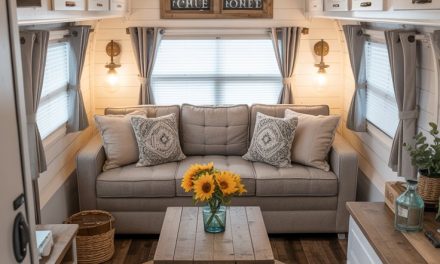Would you like to save this article?
Living in an RV might seem like an expensive adventure, but thousands of families are discovering it can actually save them serious money. If you’re tired of high rent payments, property taxes, and utility bills eating up your paycheck, RV living could be your ticket to financial freedom.
But here’s the honest truth: RV living can save you money OR cost you more – it all depends on how you do it.
The Simple Answer: Yes, But Only If You’re Smart About It
Living in an RV can save you 30-70% compared to traditional housing costs when done strategically. The average American spends $1,500-$3,000 per month on housing alone. Smart RVers often live comfortably for $1,000-$2,500 total monthly expenses.
However, luxury RV living with expensive resorts and constant travel can easily cost $4,000+ per month.
The key difference? Your lifestyle choices.
Real RV Living Costs: What Full-Timers Actually Spend
Let’s break down what real RV families spend each month:
Budget RV Living: $1,200-$2,000/month
- RV Payment: $300-500 (used RV)
- Campground/Parking: $400-600
- Gas: $150-300
- Food: $400-600
- Insurance: $100-150
- Phone/Internet: $100-200
- Maintenance: $100-200
Comfortable RV Living: $2,000-$3,500/month
- RV Payment: $500-800 (newer RV)
- Campground/Parking: $600-1,200
- Gas: $300-500
- Food: $500-800
- Insurance: $150-250
- Phone/Internet: $200-300
- Maintenance: $200-300
Luxury RV Living: $3,500-$6,000+/month
- RV Payment: $800-1,500 (high-end RV)
- Luxury Resorts: $1,500-3,000
- Gas: $500-1,000+ (frequent travel)
- Food/Dining: $800-1,500
- Insurance: $200-400
- Phone/Internet: $250-400
- Maintenance: $300-500
5 Ways RV Living Saves You BIG Money
1. No More Property Taxes
Average savings: $2,000-$8,000 per year
Property taxes can cost thousands annually. In states like New Jersey, homeowners pay over $8,000 yearly in property taxes alone. RVers pay simple vehicle registration fees instead – usually $100-$500 per year.
2. Eliminate Utility Bills
Average savings: $150-$400 per month
No more electric, gas, water, sewer, trash, or internet bills. Your campground fee often includes these utilities. Even when paying separately, RV utilities cost much less than house utilities.
3. Dramatically Lower Insurance Costs
Average savings: $100-$300 per month
RV insurance typically costs $100-$200 monthly compared to homeowners insurance at $150-$300+ monthly. You’re insuring a vehicle, not real estate.
4. Minimal Maintenance Costs
Average savings: $200-$500 per month
Houses need new roofs ($15,000), HVAC systems ($8,000), and constant repairs. RV maintenance is predictable and much cheaper. Budget $100-$300 monthly and you’re covered.
5. Freedom from HOA Fees
Average savings: $50-$500 per month
Many neighborhoods charge $50-$500+ monthly HOA fees. RVers pay campground fees only when staying there – no ongoing community fees.
The Hidden Costs Nobody Talks About
RV Depreciation: Your Biggest Financial Hit
Unlike houses that typically gain value, RVs lose 20-30% of their value in the first year and continue depreciating. A $100,000 RV might be worth $50,000 after five years.
Money-saving tip: Buy a quality used RV that’s 3-5 years old to avoid the steepest depreciation.
Fuel Costs Can Kill Your Budget
RVs get terrible gas mileage – typically 6-12 MPG. If you’re constantly moving, fuel costs can easily hit $500-$1,000+ monthly.
Money-saving solution: Travel slowly. Stay 2-4 weeks in each location instead of moving every few days.
Campground Inflation
Campground prices have skyrocketed since COVID. What used to cost $30/night now costs $50-$80+ in popular areas.
Money-saving hack: Book monthly stays for 50-70% savings per night.
4 RV Living Scenarios: Which Saves Money?
Scenario 1: The Stationary Saver ✅ SAVES MONEY
- Buys used RV with cash
- Parks long-term at affordable RV park ($500-800/month)
- Minimal travel
- Potential savings: $1,000-$2,000/month vs. renting
Scenario 2: The Smart Traveler ✅ SAVES MONEY
- Travels slowly (2-4 weeks per location)
- Uses free camping (BLM land, state parks)
- Cooks most meals at “home”
- Potential savings: $500-$1,500/month vs. house payments
Scenario 3: The Luxury Nomad ❌ COSTS MORE
- Stays at expensive RV resorts ($100-200/night)
- Travels frequently
- Eats out regularly
- Potential costs: $4,000-$6,000+/month
Scenario 4: The Weekend Warrior ❌ COSTS MORE
- Keeps house AND RV
- Uses RV for weekend trips only
- Pays for both housing and RV expenses
- Result: Double housing costs
15 Proven Ways to Save Money RVing
Campground Savings
- Join discount programs like Passport America (50% off at participating parks)
- Book monthly stays for the best per-night rates
- Use membership programs like Thousand Trails for unlimited camping
- Free camp on BLM land – completely legal and free for 14 days
- Stay at state parks – typically $20-40/night vs. $60-100 at private campgrounds
Fuel Savings
- Travel slowly – stay weeks, not days, in each location
- Plan shorter routes – 150-200 miles max per travel day
- Drive 60 MPH max – saves fuel and prevents tire blowouts
- Use GasBuddy app to find cheapest fuel prices
- Get TSD card for diesel discounts at truck stops
Food & Daily Living
- Cook your own meals – RV kitchens save thousands vs. eating out
- Shop at discount grocery stores when possible
- Pack lunches for day trips and activities
- Use campground amenities like pools, recreation, and WiFi
- Choose free outdoor activities – hiking, swimming, exploring nature
The Breakdown: RV vs. House Costs Comparison
| Expense Category | Traditional House | Smart RV Living | Potential Savings |
|---|---|---|---|
| Housing Payment | $1,500-$3,000/month | $500-$1,200/month | $1,000-$1,800/month |
| Property Taxes | $200-$800/month | $10-$50/month | $150-$750/month |
| Insurance | $150-$300/month | $100-$200/month | $50-$100/month |
| Utilities | $200-$400/month | $0-$100/month | $100-$300/month |
| Maintenance | $300-$500/month | $100-$200/month | $200-$300/month |
| HOA Fees | $50-$500/month | $0/month | $50-$500/month |
| Total Monthly | $2,400-$5,500 | $710-$1,750 | $1,550-$3,750 |
Annual Savings Potential: $18,600-$45,000
When RV Living DOESN’T Save Money
Be honest with yourself – RV living won’t save money if you:
- Want to stay at luxury resorts constantly
- Plan to travel extensively (moving every few days)
- Can’t give up dining out regularly
- Need extensive workspace setups
- Prefer urban convenience over outdoor experiences
- Aren’t willing to downsize possessions significantly
Free vs. Paid Camping: Your Biggest Money Decision
Free Camping Options
- BLM Land: 14 days free, thousands of locations
- National Forest: Usually free, scenic locations
- Walmart/Business Parking: One night stops only
- Harvest Hosts: Free camping at farms/wineries (membership required)
Budget Camping ($10-30/night)
- State Parks: Great amenities, beautiful locations
- County Parks: Often overlooked gems
- Corps of Engineers: Lakeside camping, reasonable rates
Premium Camping ($40-150+/night)
- Private RV Resorts: Full amenities, pools, activities
- KOA Campgrounds: Consistent quality, family-friendly
- Luxury RV Parks: Resort-style amenities
Money-saving strategy: Mix free and budget camping with occasional premium stays for special occasions.
The Real Financial Benefits Beyond Monthly Savings
Build Your Emergency Fund Faster
With lower monthly expenses, many RVers save $500-$2,000+ monthly that would have gone to housing costs. This builds emergency funds rapidly.
Pay Off Debt Quicker
Lower living costs mean more money for debt payments. Many RVers eliminate credit card debt and student loans years faster.
Early Retirement Opportunity
Reduced living expenses make early retirement feasible. Some couples retire 10-15 years earlier through RV living savings.
Location Independence
Work from anywhere with internet. This opens up job opportunities and allows living in lower-cost areas.
Essential RV Money-Saving Tools & Apps
Campground Finding & Booking
- Campendium: Find free and cheap camping
- FreeRoam: Discover boondocking locations
- Reserve America: Book state and federal campgrounds
- RV LIFE: Trip planning with RV-specific routes
Money-Saving Memberships
- Passport America: 50% off camping ($44/year)
- Good Sam: 10% campground discounts + roadside assistance
- Harvest Hosts: Free camping at farms/wineries
- Thousand Trails: Unlimited camping membership
Budget Tracking
- YNAB (You Need A Budget): Track RV living expenses
- Mint: Free budget tracking
- RV Living Budget Spreadsheets: Available free online
YouTube Video: Real RV Living Costs
This RVer explains how her budget dropped 70% after moving to full-time RV living
Getting Started: Your RV Money-Saving Action Plan
Phase 1: Planning (2-6 months before)
- Calculate your current housing costs (include everything: rent/mortgage, taxes, utilities, maintenance, HOA)
- Research RV prices in your budget range
- Test RV living with rentals or short trips
- Plan your route focusing on low-cost regions initially
Phase 2: Transition (Month 1-3)
- Buy a quality used RV to avoid depreciation hit
- Establish mail forwarding service
- Switch to RV-friendly insurance
- Join money-saving memberships
Phase 3: Optimize (Month 4+)
- Track your actual expenses for 3 months
- Adjust travel speed based on fuel costs
- Find your ideal campground mix (free vs. paid)
- Build emergency fund with monthly savings
The Bottom Line: RV Living CAN Save You Money
Yes, living in an RV can absolutely save you money – potentially $1,500-$3,000+ monthly compared to traditional housing. However, savings aren’t automatic.
You’ll save money if you:
- Buy a quality used RV instead of financing new
- Travel slowly and stay longer in each location
- Use a mix of free and budget camping
- Cook most meals in your RV
- Focus on outdoor activities and experiences
You won’t save money if you:
- Finance an expensive new RV
- Stay at luxury resorts constantly
- Travel frequently (moving every few days)
- Eat out regularly and live like you’re on vacation
The average smart RVer saves $18,000-$45,000 annually compared to traditional housing costs. That’s enough to retire earlier, pay off debt, or simply enjoy life with less financial stress.
Ready to start your RV money-saving journey? Begin by calculating your current housing costs and researching quality used RVs in your price range. Your financial freedom might be just one RV purchase away.
Meta Description:
Can living in an RV save you money? Yes! Smart RVers save $18,000-$45,000 annually vs traditional housing. Learn the real costs, money-saving strategies, and how to make RV living profitable in 2025.
Sources:
- EcoFlow – Is It Cheaper to Live in an RV Than a House?
- Mortons on the Move – How To Save Money By Living In An RV
- Nomads With A Purpose – Cost Of RV Living Full Time
- The Adventure Detour – How Do People Afford To Live In An RV Full Time
- Heath & Alyssa – How Much Does It Cost to Live in an RV Full-Time





